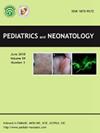Factors associated with scoliosis development in patients with congenital diaphragmatic hernia: A single-center retrospective study
IF 2.1
4区 医学
Q2 PEDIATRICS
引用次数: 0
Abstract
Background
Scoliosis is the most frequent complication of musculoskeletal abnormalities in patients with congenital diaphragmatic hernia, but the factors that related to its development and severity remain largely unknown. This study aimed to investigate the clinical factors associated with the development and severity of scoliosis in patients with congenital diaphragmatic hernia.
Methods
Thirty-two patients admitted to the neonatal intensive care unit for congenital diaphragmatic hernia at the University of the Ryukyus Hospital between 2004 and 2019 were retrospectively analyzed, particularly those who were discharged alive and had available chest radiographs at 4–5 years of age from medical records. The presence of scoliosis was determined using the chest radiographs. Basic and medical information was also extracted from the patients’ medical records.
Results
Factors associated with scoliosis development were an Apgar score <7 points, liver prolapse, and intubation period. The Cobb angle exhibited a significant positive correlation with intubation period, hospital stay duration, and tube feeding duration.
Conclusion
Patients with severe congenital diaphragmatic hernia have a high risk of developing scoliosis and may need to begin comprehensive intervention by a multidisciplinary medical team at an early stage.
先天性膈疝患者脊柱侧凸发展的相关因素:一项单中心回顾性研究
背景:脊柱侧凸是先天性膈疝患者最常见的肌肉骨骼异常并发症,但与其发展和严重程度相关的因素在很大程度上仍然未知。本研究旨在探讨先天性膈疝患者脊柱侧凸发展及严重程度的相关临床因素。方法:回顾性分析2004年至2019年在琉球大学医院新生儿重症监护室收治的32例先天性膈疝患者,特别是那些活着出院并在医疗记录中有4-5岁胸片的患者。脊柱侧凸的存在是通过胸片确定的。还从患者的病历中提取了基本信息和医疗信息。结论:重度先天性膈疝患者发生脊柱侧凸的风险较高,可能需要在早期开始多学科医疗团队的综合干预。
本文章由计算机程序翻译,如有差异,请以英文原文为准。
求助全文
约1分钟内获得全文
求助全文
来源期刊

Pediatrics and Neonatology
PEDIATRICS-
CiteScore
3.10
自引率
0.00%
发文量
170
审稿时长
48 days
期刊介绍:
Pediatrics and Neonatology is the official peer-reviewed publication of the Taiwan Pediatric Association and The Society of Neonatology ROC, and is indexed in EMBASE and SCOPUS. Articles on clinical and laboratory research in pediatrics and related fields are eligible for consideration.
 求助内容:
求助内容: 应助结果提醒方式:
应助结果提醒方式:


